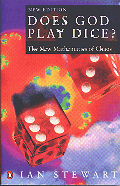Does God Play Dice?
|
|
Dice and Determinism
In the next subsection I'm going to describe a new idea which gets round
Bell's inequality in a very clever way. As preparation, let me first develop
the argument that along with that mainstay of probability theory texts,
the fair coin, the 'dice' metaphor is one
of the most inappropriate ever invented. At least, unless we revise our idea
of randomness.
I'm talking of an ideal die, a perfect inelastic cube, thrown
on to a perfectly flat inelastic surface, subject to some precise law of
friction, and obeying Newtonian mechanics. I have to do that to introduce
the mathematics precisely. It seems to me that whatever makes a real die
random ought to show up in this model too. Putting on Laplace's hat, however,
it's clear that Vast Intellect could work out the final rest state of the
die the moment it's thrown. With a video-camera and a supercomputer we ought,
at least in principle, to be able to predict the outcome before the die
does.
This isn't entirely a fantasy. J. Doyne Farmer, an
American chaologist, developed a theory of the roulette wheel which improves
considerably on pure chance. He's having trouble getting the casinos to let
him play, though.
Anyway, if you can predict exactly what will happen, where does the
randomness come from?
I can't do calculations for a die, but I'll do them for a
simplified coin, close enough to show what's involved. The coin is a line
segment of unit length, confined to a vertical plane. When it is tossed,
starting at ground level, it's given a vertical velocity v and also
a rotation rate of r turns per second. When it
returns to ground
level, it freezes: whichever side is then uppermost is considered to
be the result of the toss.
If g is the acceleration due to gravity, then the coin
takes 2v/g seconds to return to the horizontal, and so makes
2rv/g turns. The boundary between heads and tails occurs at
exact half-turns, that is, when 2rv/g is half an integer. If
this integer is is N,then the head/tail boundary is given by vr
= gN/4.
 |
Initial conditions for a spinning coin, striped according to its eventual fate. Black = heads, white = tails. |
If I could control the values of r and v exactly,
then I'd be able to make the coin land whichever way up I want. However,
in practice I can control these values only within limits. For example,
suppose that I can keep v between 480 and 520 cm/sec, with r
between 18 and 22 revolution per second. How does the outcome heads or tails
- depend on v and r?
You can get the answer from the formula above. The rectangle
of possible values of v and r divides into stripes: black for
heads, white for tails (see diagram).
Any known values of the initial velocity and the rate of spin give
a unique answer. Not only is the outcome deterministic I really can tell
you, in advance, what it is.
But if all I know is that v and r lie within
the given range, I can't prescribe the outcome. The best I can do is think
of the rectangle as a kind of dartboard. Each coin-toss is like throwing
a dart: if the dart hits a black stripe, I get a head, if white, I get a
tail. If the darts are distributed uniformly over the rectangle, then the
probability of a head is the proportion of the total area covered by black
stripes.
In others words, the source of the randomness lies in the
choice of initial conditions. Unless I can control them exactly, I
can't make a precise prediction.
Here Laplacian determinism breaks down again - but in a subtly different
way. The model coin isn't a chaotic system. It's a perfectly regular one.
What we see here is that, associated with any deterministic
dynamical system, there is a probabilistic system that offers a kind of
'coarse-grained' representation. Instead of telling us exactly which point
in phase space the system occupies
at a given instant, it tells us just the probability that the point lies
in a given region at some instant. The study of such probabilities, called
invariant measures, goes back to the early days of statistical mechanics,
when mathematicians and physicists were trying to understand gases as complex
collections of molecules, bouncing madly off each other. Invariant measures
explain why gases have well-defined average properties like density and pressure.
You might say that before we understood the molecular basis of matter, the
only things we knew about the dynamics of gases were probabilistic. Afterwards,
we realized that the probabilities are derived from a deterministic - but
incredibly complicated - underlying dynamic. So statistical mechanics does
have a hidden variable theory, whose variables are the positions and velocities
of the gas's component molecules.
Could quantum theory be similar? Our experience to date makes
us think that it is irreducibly probabilistic, but where do the probabilities
come from? Probabilities are patterns, of a kind, and it is actually rather
bizarre to think of probability as a primary physical concept when in every
case where we understand the deep structure, probabilities arise from a
deterministic dynamic as invariant measures. Indeed the existence of well-defined
statistical patterns is evidence for a kind of order that becomes apparent
only when we average over long timescales. What makes the system's distant
future resemble its past, even on average? If it's really random,
why aren't they just different? If a radioactive atom decays in a manner
that has we'll-defined statistical regularities, where do those regularities
come from? To say they are fundamentally probabilistic, and leave it at that,
is simply to postulate a pattern that ought to be explained.
For deterministic chaos, in contrast, there is a clear mathematical
explanation of the associated probabilities and their statistical regularities.
We know where they come from: they arise as invariant measures. Although
we don't understand everything here that we'd like to - for example the existence
of technically 'nice' invariant measures is widely conjectured but narrowly
proved - we see very clearly that it is the determinism of the dynamics that
makes the future look similar to the past. The reason is recurrence:
deterministic systems keep returning close to their previous states. So,
paradoxically, it is the underlying determinism of the system that makes
probabilities applicable. In order for a coarse-grained model to fit, there
has to be something fine-grained to coarsen.
It seems to me that a truly random system ought not to exhibit
patterns at all, not even on average. I'm aware that this view is a minority
one, and I'm also aware that in some ways it conflicts with
Gregory Chaitin's beautiful 'algorithmic information
theory', which defines randomness in a manner that necessarily implies
statistical regularities. I'm aware that complexity theory (see Chapter
17) suggests that patterns need not 'come from' anywhere, and I'm inclined
to agree. But I still think that there's a grain of truth in the idea.
I think that the existence of statistical regularities in quantum level matter
needs to be explained, not simply assumed; and some kind of chaotic hidden
variable theory would fit the bill - if only it weren't for Bell's
inequality.
However, there are more ways to Bell a cat than choking it
with correlations. In principle, we can get round Bell's inequality. I don't
know if this can be done while remaining consistent with every known experimental
result about quantum mechanics that needs further research. However, despite
Bell's inequality, we don't have to give up at the outset. Bell's inequality
tells us that certain kinds of 'hidden variable' extension of conventional
quantum theory can't possibly work, but it doesn't rule out every conceivable
extension or alternative. It is a constraint that tells us a little bit about
what kind of hidden variable model we can introduce.
I have a feeling that physicists may have been too easily impressed
by a mathematical theorem. Mathematicians know that theorems have hypotheses,
assumptions that you have to make before the theorem works. Indeed mathematicians
spend a lot of time writing down their hypotheses very carefully, thereby
infuriating the physicists, who prefer to be sloppy (they call it 'appeal
to physical intuition') and leave the hypotheses tacit. This is fine for
everyday nuts-and-bolts physics, but I think it can be horribly misleading
when we get down to fundamental philosophical issues, where some careful
logic-chopping is necessary.
A careful study of the requisite hypotheses reveals potential
loopholes in the proof of Bell's inequality. There are several hidden
assumptions, technical things like the uniqueness of the probability measure
used to compute the correlation function and the convergence of various infinite
series and integrals. These loopholes are probably pluggable, but very recently
it has been shown that at least one is not.
Let's take a peep inside Pandora's quantum box.

